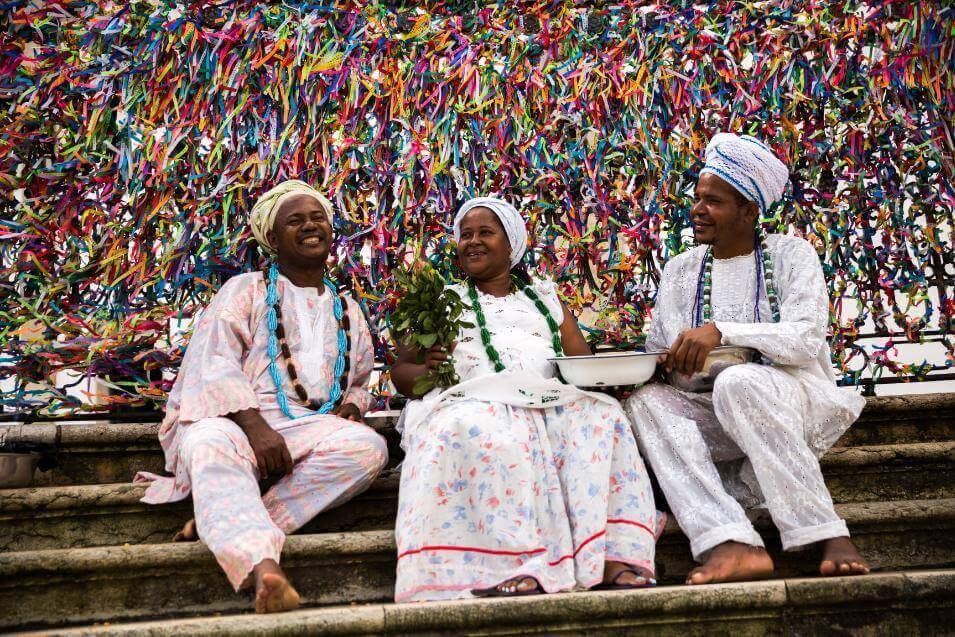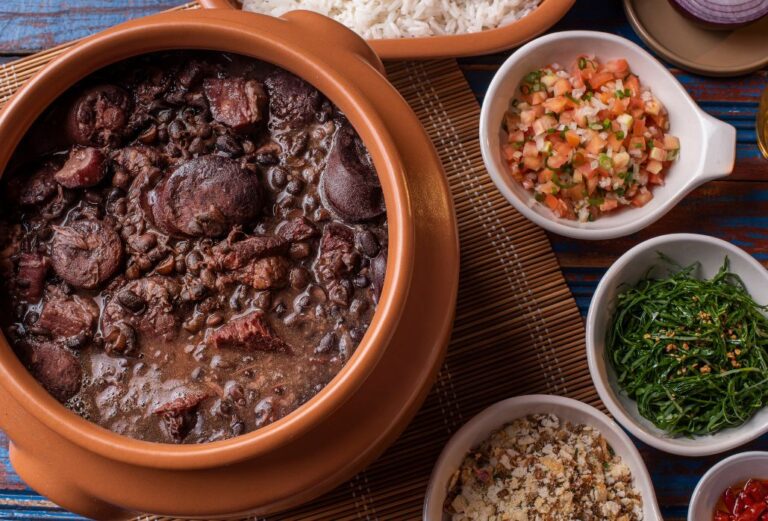Candomblé: the Incredible Rhythm of Religion
HAVE YOU HEARD OF THE CANDOMBLÉ RELIGION
It’s New Year’s Eve in Rio. At the stroke of midnight, as millions of people watch the spectacular fireworks and drink champagne on Copacabana Beach, others, dressed in white, rush to the shoreline to jump over seven waves in hopes of being granted seven wishes for the following year.
To new arrivals, this may seem like nothing more than an interesting local tradition. However, its roots lie in a tradition of African origin. White flowers are thrown into the sea, and small tokens of mirrors and perfume, lit by twinkling candles, are loaded into boats and pushed out from the shore.
Images and figurines of a female deity swathed in white, silver, and blue are everywhere, and these offerings are for her. She is Lemanjá (sometimes spelled Yemanjá), the goddess of the ocean, and these rites are part of the religion known as Candomblé.
Origins of Candomblé

Tracing the origins of Candomblé brings us to the heart of West Africa, where vibrant and complex spiritual traditions thrived among the Yoruba, Bantu, and Fon societies. These diverse religious practices were woven into the fabric of everyday life, providing a spiritual lens through which these societies interacted with the world.
However, these practices underwent significant transformations due to the harsh realities of the slave trade. Enslaved Africans transported to Brazil were pressured into adopting Roman Catholicism, the religion of their enslavers. Despite this forceful imposition, the enslaved found innovative ways to maintain their religious practices.
They cleverly embedded their deities, known as orixás from the Yoruba religion and culture, voduns from the Fon culture, and nkisis from the Bantu culture, within the iconography of Catholic saints. On the surface, they appeared to be practicing Catholicism, but in reality, they were preserving their ancestral religions.
The Abolition of Slavery
With the abolition of slavery in the 19th century, Afro-Brazilian communities faced the challenge of reclaiming their religious heritage. They endured marginalization and opposition from more dominant religious establishments but remained resilient.
The 1970s marked a significant era for Candomblé practitioners, as they could finally openly celebrate their faith without fear of persecution. Today, Candomblé stands as a poignant reminder of the endurance of African spiritual traditions within the diaspora, emphasizing the resilience of faith through challenging circumstances.
Candomblé appropriates beliefs from both African traditions and Christianity. This Afro-Brazilian religion found its strength in the spirits of its ancestors. The chief deity, Oludumaré, is at the helm, served faithfully by the orixás, spirits of ancestors.
⭐️ Where is Candomblé practiced? Candomblé is primarily practiced in Brazil, where it originated. It is particularly prominent in Salvador, Bahia, often considered the heartland of Candomblé due to its strong Afro-Brazilian population. But it is also practiced in other Latin American countries and other parts of the world.
What Are Orixás?

The orixás are deified ancestors or natural spirits that serve as a bridge between the earthly realm and the divine. They are intermediaries between humans and the supreme god, Oludumaré. They’re seen as both ancient deities and forces of nature, each possessing their own realm, attributes, and offerings.
Some key orixás include:
- Oxalá: Known as the creator of humankind and the father of all orixás. He is associated with light, creation, and purity.
- Yemanjá: The mother of all orixás, she is the goddess of the sea and the patroness of fishermen. She symbolizes motherhood, fertility, and family.
- Oxóssi: The orixá of hunting and the forests — he represents abundance and food provision.
- Ogum: The god of iron, war, and work, he is often called upon for protection.
- Oxum: The goddess of love, gold, and beauty, she also rules over rivers and fresh water.
- Iansã (Oya): The goddess of winds, tempests, and change, she is a fierce warrior and the guardian of the cemetery.
- Xangô: The god of fire, thunder, and justice, he is known for his quick temper but also for his sense of fairness.
- Exu: Often misunderstood, Exu is the trickster god, the god of chaos and unpredictability. He is also the messenger god, carrying communications between humans and the other orixás.
Candomblé practitioners believe that each person has a unique connection to a specific orixá, who provides guidance, protection, and influence in their lives. Their specific orixá is chosen for them before their birth. This personal orixá, known as their head orixá, has a strong influence on their personality and destiny.
⭐️ It’s also important to note that the orixás are not worshipped in the same way as gods are in other religions. Instead, they are venerated and called upon for guidance, protection, and help. Followers of Candomblé seek to learn from the orixás’ examples and live in harmony with the natural forces they embody.
The Rituals and Ceremonies of Candomblé

Candomblé, as a religious faith, has a rich tapestry of rituals and ceremonies. These sacred practices play a crucial role in allowing practitioners to connect with their orixás, especially during key moments in the annual calendar.
Music and Dance in Candomblé Worship

At the very heart of Candomblé is the rhythmic pulsation of music and dance, serving as channels for divine communication. The name Candomblé itself translates to “dance in honor of the gods.” As the rhythm surges, so does the spiritual energy, creating a vibrant, dynamic atmosphere of celebration and reverence.
Drums of different sizes, bells, and the xequerê (a gourd covered in beads) create the rhythm that shapes the sacred dances, accompanied by chants in the ancient Yoruba language. These beats and melodies are more than just auditory delights; they form a complex spiritual language that invites the orixás to join the ceremony.
The dance is an essential part of this worship, with each orixá having its unique dance pattern and rhythm, reflecting its characteristics and the natural element it commands. The dances can range from the gentle swaying of Oxalá, the senior orixá, symbolizing the slow but steady pace of creation, to the fierce, martial dance of Ogun, the deity of iron and war.
The Role of Offerings and Sacrifices
One integral part of the Candomblé faith is the tradition of making offerings and sacrifices to the orixás. These gestures are ways to show respect, seek favor, and maintain a harmonious relationship with these spiritual entities.
The nature of offerings varies, often reflecting the preferences of specific orixás. Offerings can include foods, drinks, and other symbolic items. For example, Yemanjá, the mother of all orixás, is often presented with items associated with femininity and motherhood, like perfume, jewelry, and mirrors.
In addition to offerings, animal sacrifices play a crucial role in some ceremonies. This practice, known as Axexê, is believed to reestablish harmony and balance in the world. Please note that these sacrifices are conducted with a deep sense of reverence, with the chosen animals treated with respect before, during, and after the process.
New Year’s Eve: A Tribute to Yemanjá

New Year’s Eve, known as Reveillon in Brazil, is a particularly significant time for practitioners of Candomblé. The most iconic tradition is the tribute to Yemanjá, the goddess of the sea, where millions flock to the shoreline, dressed in white, for the ritual of wave-jumping.
At the stroke of midnight, Candomblé practitioners rush to the ocean’s edge and jump over seven waves. Each wave jumped signifies a wish being made, with the hope that Yemanjá will grant these seven wishes in the new year.
The sea, Yemanjá’s realm, is seen as the source of all life, and the waves are its pulsating heartbeat. Jumping over the waves is a gesture of respect and homage, a physical demonstration of the practitioner’s trust in the orixá‘s power to cleanse, renew, and transform.
Alongside this ritual, offerings, known as Ebó, are made to Yemanjá. They often include flowers, perfumes, mirrors, and other tokens of appreciation, bundled into tiny boats and set adrift on the ocean. The belief is that if the sea accepts the offerings (if the boats don’t return to shore), Yemanjá is pleased, and the forthcoming year will be one of blessings.
Washing of Bonfim (Lavagem do Bonfim)

Washing of Bonfim (Lavagem do Bonfim) is a significant religious event in the Candomblé tradition and one of the most important festivals in the city of Salvador, in the state of Bahia, Brazil.
The festival happens on the second Thursday of January and attracts thousands of locals and tourists alike. It begins with a procession that starts at the Church of Conceição da Praia and travels 8 kilometers to the Church of Bonfim.
The “washing” refers to the main ritual of the festival, which involves Candomblé followers, mostly women known as “Baianas”, cleaning the steps and the pathway of the Church of Bonfim using scented water. This ritual symbolizes purification and the washing away of evil.
Although it has a Catholic background – the Church of Bonfim is a Catholic institution – the event reflects the syncretic nature of Brazilian religious practices. The figure of Our Lord of Bonfim (Jesus Christ) is often associated in Candomblé with Oxalá, the orixá of creation, highlighting the blend of Christian and African beliefs.
The Washing of Bonfim illustrates the lively, colorful nature of Candomblé ceremonies, as well as the sense of unity and joy that permeates the community during such gatherings. It stands as a testament to the enduring strength and cultural richness of the African diaspora in Brazil.
Experience Candomblé: From Markets to Tours

Stepping into the world of Candomblé isn’t limited to solemn religious ceremonies or temples (or terreiros). It permeates everyday life, from bustling markets to immersive cultural tours, offering an enriching glimpse into Brazil’s syncretic spiritual landscape.
In the vibrant markets of Bahia, you can find a plethora of items associated with Candomblé. From vividly colored beads representing different Orixás to intricate altars and effigies, these markets are treasure troves of Candomblé symbolism. Here, the rhythm of sacred drums might lead you to a stall selling guias (beaded necklaces), each color scheme representing an Orixá. In the quiet corners, you might find small carved figures of Orixás, silent testimonies of faith amid the chaos.
Moreover, there are cultural tours that plunge you directly into the heart of the Afro-Brazilian religion. Guided tours in Salvador, the Brazilian city most closely associated with Candomblé, allow visitors to visit terreiros (temples), witness sacred rituals, and interact with local practitioners. These tours offer an understanding of the religion not merely as a faith but as an integral part of Brazilian culture and identity.
Etiquette tips for Candomblé
Should you have the opportunity to attend a Candomblé ceremony or festival, it’s important to keep these etiquette tips in mind:
- The primary language of Candomblé is Yoruba, an African language from Nigeria. Terreiros, are Candomblé temples.
- Modest dressing is key. Wear clothes that are comfortable and respectful to the religious environment. White is the preferred color in many ceremonies.
- To respect the sanctity of the event, video recording or photography is usually not permitted during ceremonies.
- Visitors are typically observers. Participation in the ceremony is reserved for practitioners. Never interrupt a ceremony or a ritual in progress. This is regarded as a serious breach of etiquette.
- Observe and follow the crowd. If everyone stands, you should too.
- While real terreiros may not have a set admission fee, donations are always appreciated.
Controversies Surrounding Candomblé

Despite the resilience and spiritual depth of Candomblé, the religion has faced its share of controversies, much of it owing to misconceptions and stereotyping. A significant portion of these misunderstandings stem from the use of the term macumba.
Macumba religion, in its broadest sense, is an Afro-Brazilian religion characterized by the syncretism of traditional African religions, European culture, Brazilian Spiritualism, and Roman Catholicism. It is not a homogenous entity. It is a term often used to denote various Afro-Brazilian religions, including Candomblé and the Umbanda religion, but is largely misunderstood.
Further confusion arises from the term macumba being associated with black magic. Instead, it symbolizes the resilience and adaptability of Afro-Brazilian spiritual practices.
Final Thoughts: The Candomble Religion

In the diverse and vibrant religious landscape of Brazil, Candomblé stands out as a powerful expression of the country’s African diaspora. One may ask, what is the main religion in Brazil? While Christianity in Brazil today, specifically Roman Catholicism, is the Brazil main religion, Afro Brazilian religion Candomblé forms an integral part of the country’s spiritual tapestry.
Contrasting with the patriarchal structures in Brazil’s predominant Christian denominations, black women have been instrumental in preserving and propagating Candomblé. As mães de santo or priestesses, these women hold significant spiritual and community authority, guiding macumba ritual, nurturing new practitioners, and maintaining the religion africana umbanda.
The vibrant Brazilian candomble is a testament to the dynamism and resilience of its followers. Despite changes and global influences, Candomble religion continues to adapt, remaining a vital part of Brazilian spiritual life. This rich history and ongoing impact emphasize the need for understanding and dialogue among Brazil’s many brazil major religions. Despite trials and controversies, candomble endures, serving as a symbol of identity and resistance for Afro-Brazilians



